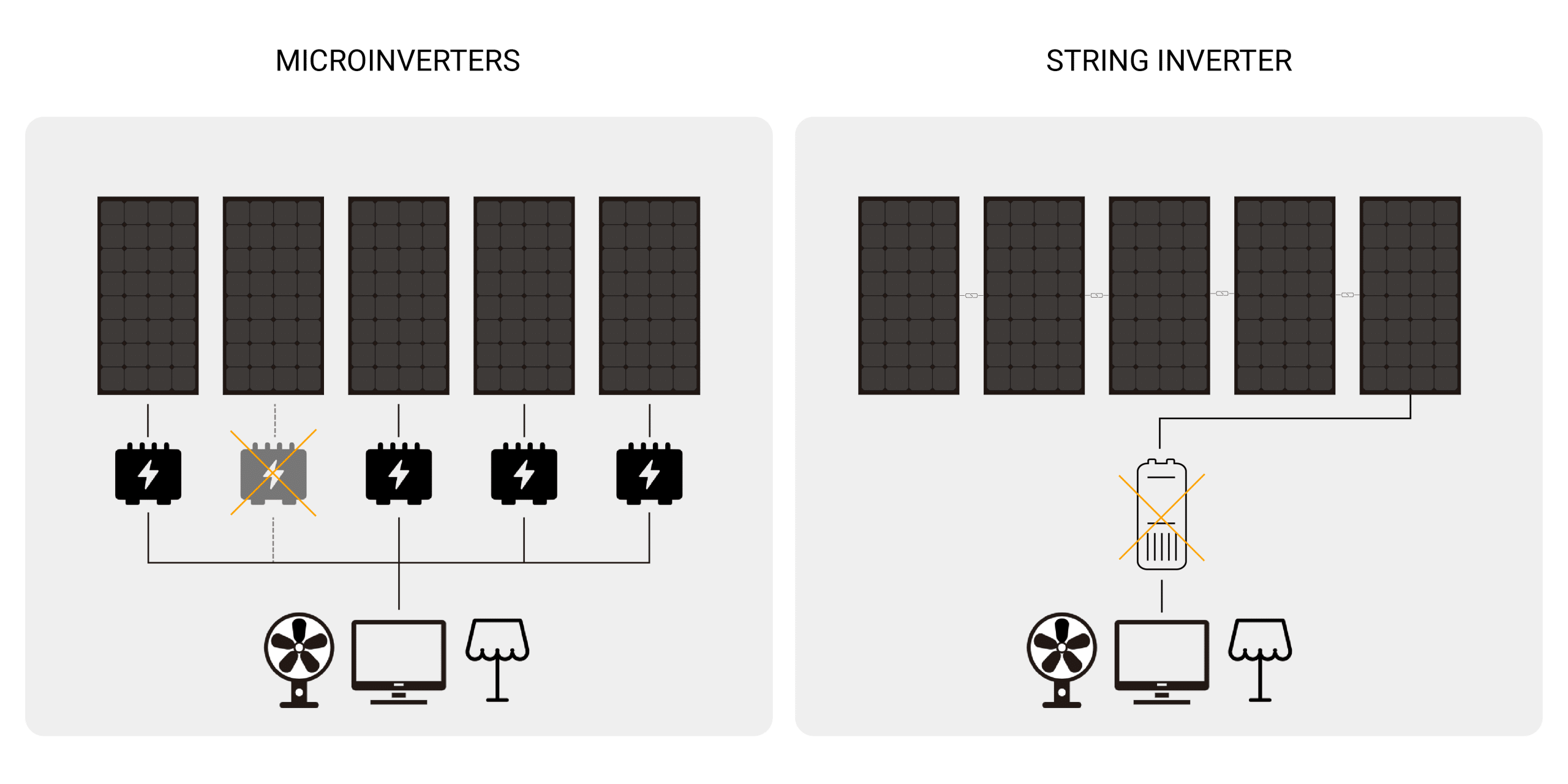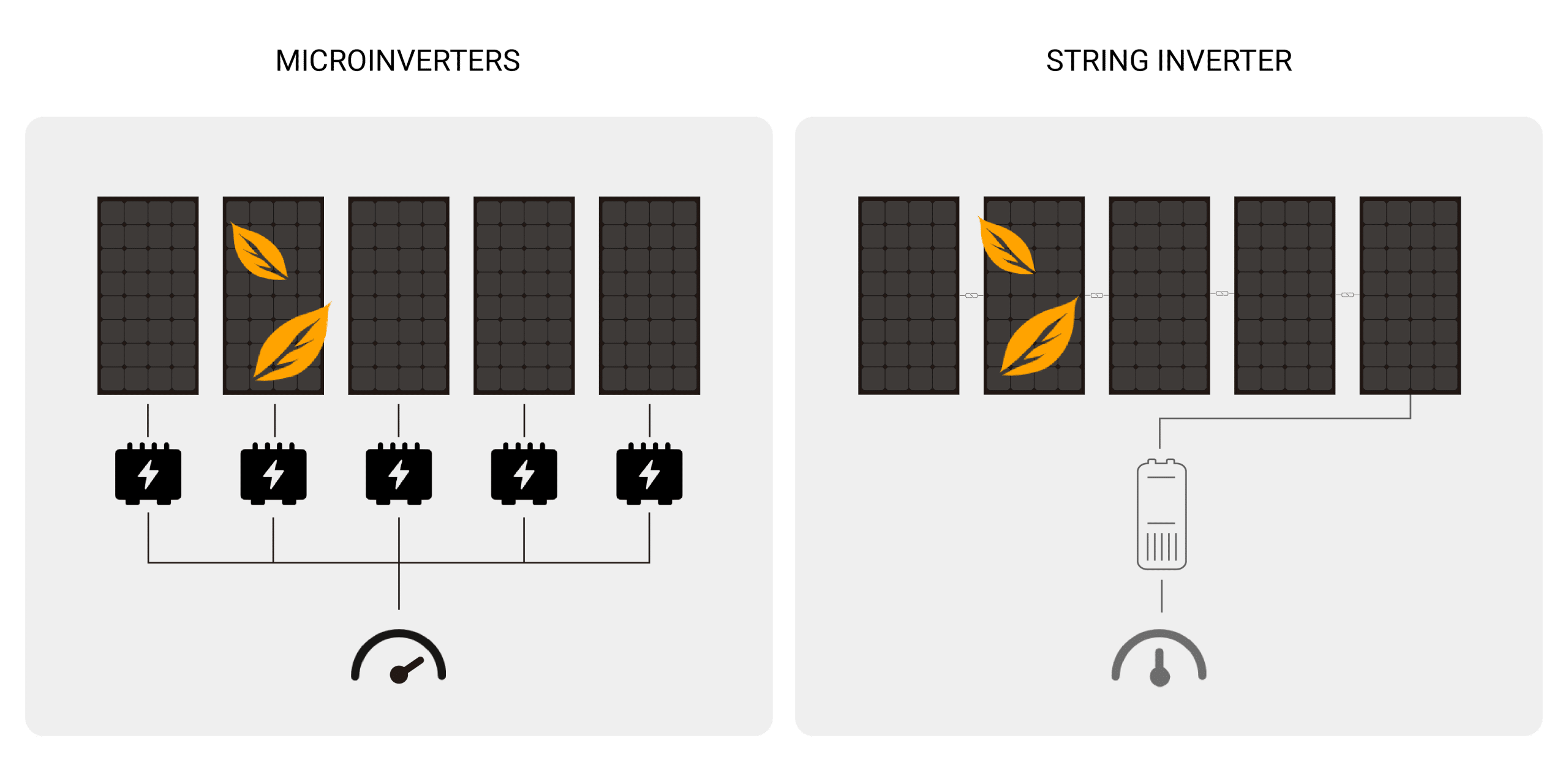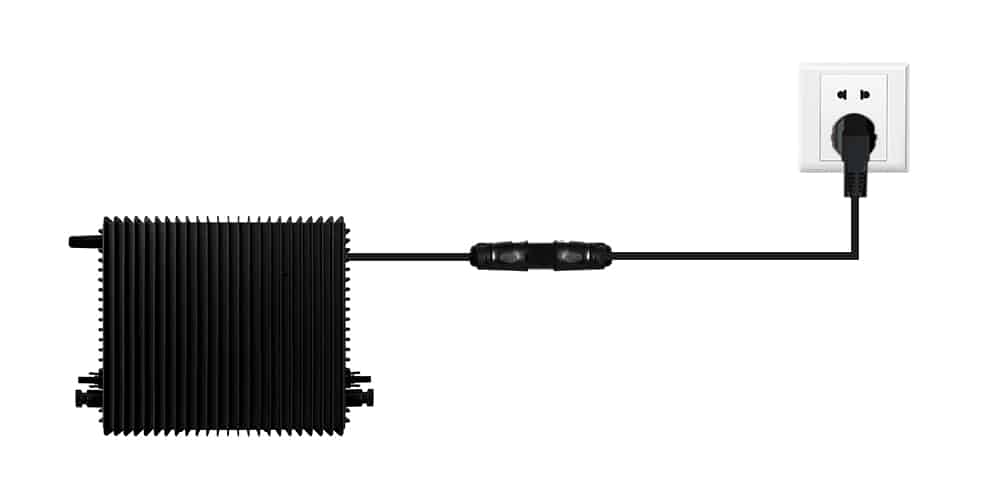With Hemax, you get an industry-leading microinverters with the lowest failure rate and high-quality components. So you can maximize production, eliminate power waste, and accelerate your open energy journey.
Table of Contents
What is a solar microinverter?
A microinverter is a small electronic device that converts direct current (DC) into alternating current (AC). A micro inverter can be the size of a book. The main difference between microinverters and traditional inverters is that they operate at the panel level rather than on the entire solar panel system.
Microinverters are classified as module-level power electronics (MLPE). Therefore, the power rating of these grid-tied inverters is much smaller – just enough to convert DC power from a mono solar panel to AC power. The size of each microinverter is determined by the size of the panel and the amount of power it is capable of producing (determined by your geographic location, tilt, direction you are facing, etc.). If your solar panels produce more power than their microinverters can convert at a given moment, “clipping” occurs, resulting in a loss of power.
Most solar microinverters are plug-and-play devices, meaning you can connect and operate them in a few simple steps, or disconnect them without using much time or tools. They often come with built-in MC4 connectors for quick and easy connection.
They are also equipped with remote monitoring technology, which means you can check the status of each microinverter on a smartphone app and therefore the solar performance of each panel.
Microinverters vs. other inverters
Power Optimizers and Microinverters
Unlike microinverters and string inverters, power optimizers do not instantly convert DC power to AC power. Instead, they “condition” it and send it to a centralized inverter. These module-level power electronics (MLPE) are very similar to microinverters in that they can monitor the performance of individual solar panels and allow the flexibility to build solar systems on edge-shaded roofs.
String inverters and microinverters
The most significant difference between string inverters and microinverters is that when wiring your panels with a string inverter, you only need to use one or two strings, depending on the size of your solar system type inverter (often called “string”). This makes troubleshooting much more manageable if your system fails, as all 6-12 panels of the inverter rack are connected to only one destination. String inverters are also cheaper to install and maintain than microinverters, given minimal wiring requirements. That being said, a simplified wiring scheme can also make it more expensive to expand your solar system in the future. This also means that a poorly performing solar panel will affect the entire circuit, not just its own output.

Get the difference at constant power

Get the difference at maximum power
What are the advantages and disadvantages of microinverters?
Advantages of microinverters
- Easy installation: Microinverters are also a good option from an installer’s perspective. Traditional inverters are bulky and difficult to carry and install. Microinverters solve this problem by being much smaller; not only are they easy to carry, but they are also connectable.
- Quick closing capability; If firefighters, first responders, or utility personnel need to access your roof for emergency or power line service, you will need to shut down your solar photovoltaic system (PV system) so that they are protected from high voltage. Microinverters can quickly and efficiently cut off power from solar installations.
- Easy system expansion: You install a 3 kW solar system with a 3 kW string inverter. If your energy needs increase and you want to add another 1 kW of panels, it will be difficult to expand your inverter capacity.
- Reduce the likelihood of system shutdown: Compared with traditional inverters, the biggest advantage of microinverters is that the possibility of system downtime is greatly reduced.
- Panels level monitoring: If a single panel in a system with a string inverter stops working, the entire system shuts down. You then have to go up to the roof and inspect each solar panel for errors – an inefficient process.
- No size restrictions: String inverters have defined input and output specifications, which means you can only connect a specific number of solar panels to a single string. If a solar installation becomes too complex, array wiring becomes difficult. With microinverters, each inverter operates at the panel level, eliminating string size constraints. You can also arrange them in almost any layout without extra complexity or expense.
- Longer service life: Most string inverters on the market come with a 10- or 12-year warranty. Modern microinverters last longer and even come with a 25-year warranty, matching the lifespan of most modern solar panels.
Disadvantages of microinverters
The main disadvantages of current microinverters are that they are difficult to repair, relatively expensive, and require more equipment on the roof
When something goes wrong with a microinverter, it can be difficult to fix. First, the defective microinverter must be correctly identified on the roof. The installer then needs to come find and fix it. This is much more difficult than troubleshooting a string inverter on the side of the house. The benefit is that if one microinverter fails, the rest of the system can continue to run and power your home with solar energy.
Additionally, there are many more devices used in a microinverter system than in a string inverter system. This means more potential points of failure and higher prices
How does a microinverter system work?
Microinverters are connected to individual solar panels, which essentially allows each panel to act as its own independent power-generating device and not be dependent on the rest of the array. Each module in the system has its own MPPT (Maximum PowerPoint Tracking), which means that individual power generation is maximized regardless of its condition.

Solar microinverters can increase the overall efficiency of photovoltaic systems that are partially shaded. When a PV module is shaded, it will produce less power and therefore less current. When this happens on a traditional string array with multiple modules connected in series, each module will reduce its current output to match the current of the shaded panel. In effect, it will look like all modules in the array are shaded, and your system will produce much less power than it would lose with one shaded panel. With microinverter systems, this is not a problem because each module generates electricity in parallel with each other. Therefore, if one module is shadowed, it will not affect the output of another module on the string.
Microinverters are also easier to design and install. Homeowners who want to install a photovoltaic system but are intimidated by high-voltage DC systems can rest easy. If they have the ability to install an AC outlet in their home, they can easily learn to install a photovoltaic system with a microinverter. The reason is that all wiring is generally 20A or 30A AC wiring, which is the same as most home circuits. More AC wiring also allows the system to comply with newer NEC specifications, so the overall installation is safer.
We generally recommend microinverters for solar installations smaller than 14kW, which will cover most residential systems. Generally, if the system is larger than this, other cost factors may need to be considered, such as installed system configuration, three-phase grid, and competing string inverter systems.
How to evaluate a microinverter?
- efficiency: Just like solar panels, microinverters have varying efficiencies. The efficiency of an inverter is a measure of how much energy is lost in the form of heat during the conversion of DC to AC. Higher-efficiency microinverters result in higher overall system efficiency and more solar power generation.
- size Microinverters come in different sizes, each designed to handle different voltages. Larger microinverters will generally be more expensive; however, you don’t want to install a microinverter that is too small for the energy output of the panels in question, as this will cause excessive clipping. Microinverter manufacturers often list guidelines for the maximum DC power a solar panel should have when connected to their product.
- Warranty Most microinverter options today come with a 25-year warranty, protecting you from potential manufacturing defects or excessive degradation. However, even if two different microinverter manufacturers offer the same warranty terms, they may offer different levels of coverage as part of the warranty. When choosing solar equipment, it is important to read and compare warranties.
- price Although they are typically not the most expensive components in a solar panel installation, it is still important to weigh the price of a microinverter. Higher efficiency microinverters with longer warranties usually cost more, but depending on your solar panel system setup and your preferences, it may be worth it.
- Rapid shutdown requirements When a rapid shutdown occurs, the microinverter can automatically shut down with compliance. Each module has software that synchronizes shutdown with these rapid shutdowns, so no additional hardware is required.
The best inverter for you depends on your unique installation needs
Over the past decade, microinverters have been hailed as the next big thing in solar PV inverter technology, and rapid adoption suggests they are here to stay. Whether you should choose a traditional single inverter or a microinverter depends on several factors.
If your roof is not suitable for a traditional system layout, using a microinverter will provide you with a faster payback period and greater cost savings over the life of your PV system.
On the other hand, if you want a simple system to install in the most cost-effective way, you can opt for a high-quality string inverter from a similar brand.
You can also explore the option of adding a power optimizer to your string inverter system and save some money.
If you use newer solar technology like solar tiles, you won’t be able to take advantage of the benefits of microinverters.
Are microinverters important for balcony PV systems?
Microinverters can be used in a variety of scenarios, including industrial and commercial rooftops as well as residential projects, including home rooftops and garages. For mini solar systems like balcony solar, microinverters are particularly suitable because they are super easy to install and have lower upfront costs than traditional string inverters.
Generally, microinverters are regulatory compliant and can make your balcony solar installation easier, for example, they generally have output capacities of 600VA and 800VA and can be used with up to 450w solar panels
Usually, we can see that microinverters have two input channels and can link up to two components. Each component is independently monitored to ensure maximum power generation. The plug-and-play cable consists of field connectors and AC cables and It consists of a plug that connects to the microinverter on one end and plugs into a household socket on the other. Users can easily plug the microinverter directly into an outlet without any additional wiring.
You can choose a 600w or 800w solar balcony system according to your family’s needs, and use different inverters to match different series of photovoltaic panels.
final thoughts
To summarize, microinverters work by converting the power of each module at the source so that each module can be monitored individually. Microinverters have the ability to increase the overall efficiency of PV systems that are affected by partial shading, so if your PV system is affected by partial shading or dirt, microinverters are a good option. So if you have limited roof space, have multiple angles, need to deal with shade trees or a chimney, and you’re not sure if you want to expand the size of your solar system at some point, microinverters are a great inverter for you choose.

























